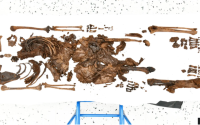First Nations Ancestral Village and ‘Rare’ 1,000-Year-Old Fish Trap Found in Canada
A rare 1,000-year-old fish trap and the remains of the ancestral village ȾEL¸IȽĆE were discovered in a suburban waterfront park by students from Canada’s University of Victoria, the Art Newspaper reported on Monday. On the homeland of the W̱SÁNEĆ nation, the site was once inhabited by roughly 250 people.
“We found a giant rock wall buried in the sand and sediment,” project leader Brian Thom, associate professor in the university’s anthropology department told TAN. “When we pulled it all away we discovered it formed a huge ‘U’ shape in the bay. It functioned as a fish trap—when the tide receded, it would catch smelt and herring.”
The excavation, which was funded by a federal job training grant, included students, Native elders, and community members. Surrounded by burial sites and fishing grounds, the site is located in the middle of expensive waterfront real estate.
The findings are rare due to the onslaught of urban development over the last 150 years in the wealthy Cordova Bay suburb in Victoria, British Columbia, Canada. The village site and enclosed fields were promised to natives in the South Saanich Treaty in 1852. The dig took place in the only section that was set aside, Agate Park.
In addition to the fish trap and ancestral village, the team also found a number of domestic tools for hunting and fishing, a fire heath, and food remnants.
In 2008, the remains of 14 bodies dating back more than 1,000 years ago were uncovered during the construction of a house. The dig yielded 350 artifacts, among them, a barbed serrated bone harpoon point.



